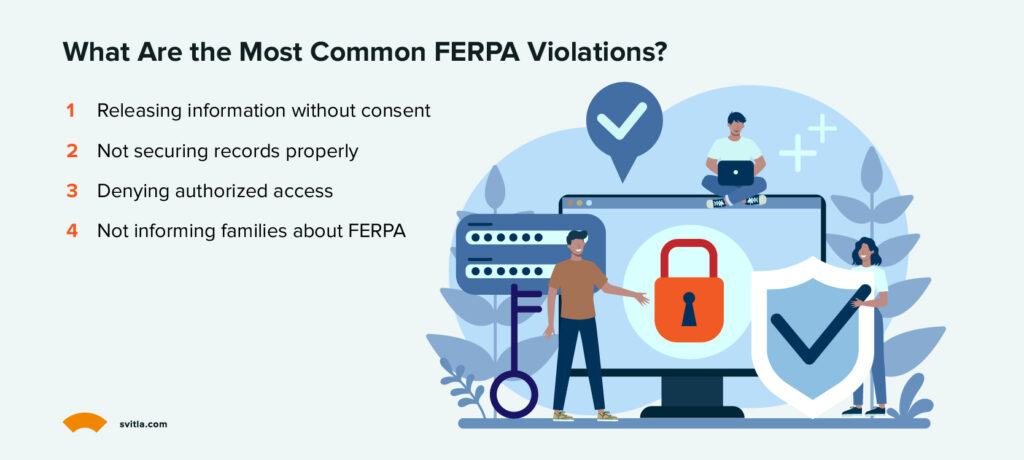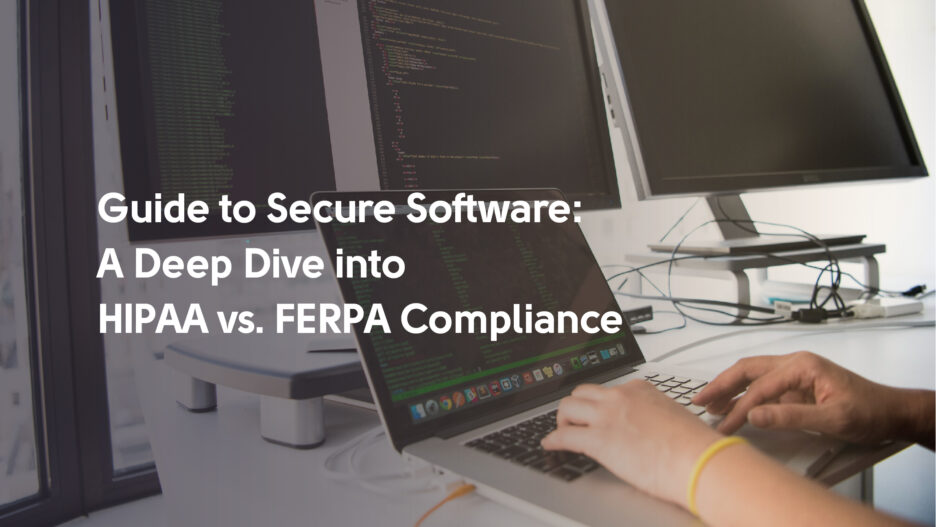Protecting personal information is more crucial than ever. Two important U.S. laws, the Family Educational Rights and Privacy Act (FERPA) and the Health Insurance Portability and Accountability Act (HIPAA), play critical roles in keeping private data safe.
This article explores the basics of FERPA and HIPAA, looking at what they protect, who they apply to, and the rights they give to individuals. We'll also touch on common mistakes organizations make in following these rules and the severe consequences that can come with violations.
Join us as we break down the essentials of FERPA and HIPAA guidelines, helping you navigate these regulations and secure sensitive information in education and healthcare.
What is HIPAA?
The Health Insurance Portability and Accountability Act, better known as HIPAA, is a critical piece of legislation passed in the United States in 1996. At its core, HIPAA guards the privacy and security of medical information.
In particular, HIPAA safeguards individuals' Protected Health Information, or PHI. This covers health data tied to a specific person, such as medical histories, test results, or insurance details. HIPAA sets clear guidelines for accessing, storing, sharing, and transmitting this sensitive information.
Healthcare providers, health insurers, and their associates must implement physical, technical, and administrative protections of PHI. For example, access to medical records must be restricted only to necessary personnel, health IT systems must have security measures in place, and policies for handling PHI must be established and followed. Violations of HIPAA rules come with stiff civil and sometimes even criminal penalties.
Beyond privacy, HIPAA also aims to make the healthcare system more efficient. It mandated standardized electronic formats for healthcare transactions, enrollment, billing, and more. This facilitates more transparent communication and data transfer between the various players in the expansive healthcare industry.
Additionally, HIPAA made it illegal for group health insurers to deny coverage because of pre-existing conditions. It also eased the process for maintaining insurance when transitioning jobs. These changes are intended to remove barriers to getting and keeping health insurance.
What is FERPA?
Since 1974, the privacy of student education records in the United States has been protected by a federal law known as FERPA. This stands for the Family Educational Rights and Privacy Act. FERPA applies to all schools, from elementary through higher education institutions, that receive funds through federal education programs.
At its core, FERPA guards students' "personally identifiable information" in education records like transcripts, disciplinary records, or other documents tied to a specific student. It restricts schools from sharing these records without explicit consent from eligible students or their parents or guardians. There are limited exceptions where schools can disclose information without consent, such as to certain school officials or during health emergencies.
Students and parents retain specific rights regarding student records under FERPA. These include the ability to review records, request corrections to inaccuracies, and control disclosure of the information to external parties. Schools must inform families annually about these rights and the institution's specific policies for abiding by FERPA guidelines.
By limiting access to and distribution of private student data, FERPA aims to protect students' privacy as they journey through the education system. Compliance is taken seriously, as schools found violating FERPA risk losing eligibility for federal funding – a consequence of potentially significant financial and reputational damage.
Over nearly 50 years, FERPA has had to adapt to new technologies like computer databases while preserving its goal of giving students and parents peace of mind over the security of grades, disciplinary issues, and other personal details. Respecting FERPA protections remains an imperative for U.S. schools and universities.
Difference of FERPA vs. HIPPAA
HIPAA and FERPA are U.S. federal laws designed to address the privacy and security of specific types of sensitive information. However, they pertain to different sectors and maintain a strict separation in their purposes and applications.
Purpose and Scope
HIPAA: HIPAA focuses on safeguarding the privacy and security of individuals' health information within the healthcare sector. It applies to healthcare providers, health plans, clearinghouses, and business associates with PHI. HIPAA aims to ensure the confidentiality and integrity of personal health data, empowering patients with control over their healthcare information.
FERPA: FERPA regulations are education-specific, aiming to protect the privacy of students' educational records and personally identifiable information (PII). Applicable to schools and higher education institutions receiving federal funding, FERPA grants students and their parents or guardians specific rights concerning the access and disclosure of educational records.
Type of Information Protected
HIPAA: Specifically guards health-related information such as medical records, health insurance claims, prescription history, and any data related to an individual's health or healthcare treatment. It also includes demographic information linked to healthcare.
FERPA: Safeguards educational records encompassing various student information, including grades, transcripts, disciplinary records, and other personally identifiable details related to a student's education.
Entities Covered
HIPAA: Pertains to covered entities like healthcare providers, health plans, and healthcare clearinghouses. Business associates handling PHI on their behalf are also subject to HIPAA.
FERPA: Applies to educational institutions receiving federal funds, spanning both public and private educational entities.
Rights and Consent
HIPAA: Grants patients rights to access their medical records, request corrections, and control the sharing of their health information. Patient consent is generally required for certain disclosures of PHI, with exceptions for permitted situations like treatment, payment, or healthcare operations.
FERPA: Provides students and their parents or guardians with the right to access and review educational records. Consent is typically required to release educational records, with exceptions for specific circumstances, such as disclosures to school officials with legitimate academic interests.
Compliance Challenges in Software Development
Ensuring compliance in software development involves technical, administrative, and enforcement measures to protect sensitive information and avoid hefty penalties. Let’s explore some main ones.
Keeping Data Secure
HIPAA requires extensive technical safeguards for electronic health data. These include access controls, encryption, audit logs, intrusion detection, and more. Regular risk assessments are also legally mandated. Developing applications that properly implement these controls requires expertise and diligence to meet evolving security standards.
FERPA has flexibility on specific security measures, but protecting student data is still critical. Schools must show they take steps to control access, prevent breaches, and maintain system integrity. Role-based access, authentication, and security training are commonly used. Encryption is recommended but not universally required.
People & Processes
Along with technical controls, HIPAA and FERPA address administrative aspects like policies, documentation, and people management.
HIPAA has strict requirements, including data use agreements, reporting procedures, sanctions for rule violations, disaster recovery plans, and a formal accountability structure. Staff must undergo privacy training.
FERPA compliance depends heavily on institutional policies and procedures. Documenting who can access information, under what circumstances, and employee training requirements is key. Though less formal than HIPAA, following standards of care with student data is mandatory.
Guarding the Guards
Robust compliance programs govern the use of sensitive data under both frameworks, but enforcement differs.
HIPAA violations carry steep civil and even criminal penalties – over $1.5 million per violation possible. Enforcement agencies like OCR conduct extensive audits and levy major fines. Breach notification laws require informing impacted individuals.
FERPA non-compliance can result in loss of federal funding, but fines are less common. Schools generally self-enforce requirements, though student privacy groups help oversee enforcement. Systematic federal audits are less extensive compared to HIPAA.
10 Best Practices to Ensure Security in Software Development
By making security a foundational priority rather than an afterthought, developers can release robust applications ready to handle the modern threat landscape. To achieve this, organizations should implement the following practices:
1. Establish a Security Foundation
Before writing any code, document potential security threats and create a comprehensive plan for integrating defenses throughout the software lifecycle – from design to testing to deployment. Define the necessary security controls and architecture.
2. Train the Team
Implement mandatory secure coding education, input validation, SQL injection prevention, cryptographic key management, and more. Ensure developers understand relevant compliance standards and their responsibilities. You can also create a checklist for your project’s specific needs.
3. Prepare an Incident Response Plan
Develop an IR plan detailing roles, responsibilities, communications protocols, investigation procedures, legal protocols, and integration with external groups. Outline methods to contain damages and restore systems and data integrity after an attack.
4. Follow Secure Coding Standards
Incorporate input validation, parameterization, proper error handling, encryption of sensitive data, access controls, the principle of the least privilege, and other vital coding best practices security across the whole software stack.
5. Comply with Regulations
Build controls, monitoring, audits, policies, and documentation to satisfy major infosec regulations and frameworks like SOC2, ISO 27001, PCI DSS, and GDPR.
6. Protect Source Code Access
Store application code in encrypted repositories with rigorous version control. Enforce 2FA access controls and strictly limit code modifications to the least authorized engineering personnel.
7. Review Code Systematically
Perform exhaustive manual code reviews before releases along with static + dynamic analysis checking for SQLi, XSS, deserialization issues, etc. Revise coding standards to prevent recurrence of findings.
8. Test Extensively
Conduct vulnerability scans, penetration tests mimicking attacks from insiders and external entities, and extensive security operations testing pre- and post-deployment to uncover gaps.
9. Monitor Operations
Implement behavioral analysis, network traffic monitoring, access control logging, vulnerability surveillance, and other tooling to detect threats and anomalies in real-time after launch.
10. Update Frequently
Routinely patch libraries/OS/frameworks and scan for new threats. Review security news to identify emerging attack techniques and proactively develop defenses through coding enhancements, configuration changes, and filtering rules.
Penalties for Violating FERPA and HIPAA
Organizations and institutions may face consequences when privacy acts like FERPA and HIPAA are breached.
FERPA
FERPA, aims to protect the privacy of student education records. However, many schools inadvertently violate FERPA due to misunderstandings about the law. Teachers and administrators should remain vigilant against these prevalent infractions:
- Disclosing records without consent. Schools cannot share student information like grades, academic status, or personal identifiers with unauthorized parties. Even accidental communication, such as misdirected emails containing student data, qualify as a violation.
- Failing to secure records. FERPA requires the proper securing of student records, whether digital or physical. Schools must restrict access to authorized personnel and properly dispose of unneeded records.
- Denying rightful access. Parents or guardians retain access rights to their minor child's records. Schools that deny this access violate FERPA.
- Not informing families about FERPA. Schools must inform families about their rights yearly and whenever policies change. Neglecting this duty constitutes a breach.
The Department of Education's Family Policy Compliance Office (FPCO) handles FERPA violations through corrective actions instead of punishments. But schools that refuse remedies risk escalating consequences like fines, loss of funding eligibility, revoked accreditation, and cease-and-desist orders until compliance is achieved. Avoiding common pitfalls is key for schools to uphold FERPA’s critical privacy protections.

HIPAA
HIPAA employs a tiered penalty system, taking into account the covered entity's awareness of violations and their response upon discovery.
- Tier 1. Unintentional violation due to lack of awareness, resulting in fines ranging from $100 to $50,000 per violation, with an annual maximum of $1,500,000.
- Tier 2. Violation with awareness or should have been aware, even with due diligence. Penalties range from $1,000 to $50,000 per violation, with an annual maximum of $1,500,000.
- Tier 3. Willful violation corrected within 30 days of discovery, incurring penalties from $10,000 to $50,000 per violation, with an annual maximum of $1,500,000.
- Tier 4. Willful violation with no corrective actions results in a flat penalty of $50,000 per violation, with an annual maximum of $1,500,000.
Understanding and adhering to these penalties is crucial for organizations to ensure compliance with FERPA and HIPAA and avoid severe consequences.
Wrapping Up
As we conclude our exploration into FERPA and HIPAA, it becomes evident that these two regulatory frameworks are guardians of sensitive information, each tailored to its specific domain – education and healthcare. In the digitally driven era, where personal data is a precious commodity, understanding and adhering to these laws is imperative for organizations handling such information.
HIPAA ensures the privacy and security of individuals' health information. FERPA, on the other hand, protects student privacy and empowers them and their families with specific rights regarding access and control over their academic journey.
The differences between FERPA and HIPAA are clear, from their purposes and the types of information they protect to the entities they cover and the rights they afford individuals. Compliance with these regulations is a commitment to preserving the trust and security of the individuals whose data is at stake.
Svitla System is here to navigate you through the complexities and challenges of healthcare regulations. Get in touch with us for a consultation.




![[Blog cover] SEO optimization best practices](https://svitla.com/wp-content/uploads/2025/05/Blog-cover-SEO-optimization-best-practices-560x310.jpg)
